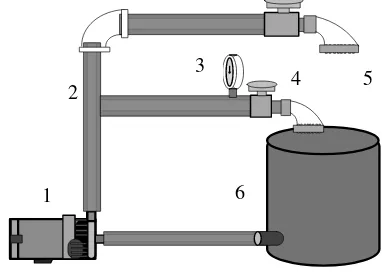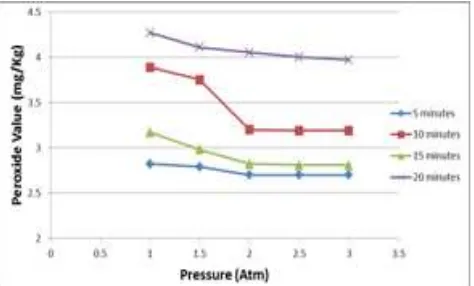Int. Journal of Renewable Energy Development 1 (2012):28-31
P a g e | 28
Contents list available at IJRED website
Int. Journal of Renewable Energy Development (IJRED)
Journal homepage: www.ijred.com
VCO Production from Fresh Old Coconut Bunch by Circulating and
Pumping Method
Muhamad Maulana Azimatun Nur
*and Joko Mulyono
Center of Biomass and Renewable Energy, Chemical Engineering Department, Faculty of Engineering, Diponegoro University, Jl.Prof Sudharto,SH-Tembalang, Semarang INDONESIA
Article history:
Received December 15, 2011 Received in revised form Feb 3, 2012 Accepted February 12, 2012 Available online
ABSTRACT: VCO (Virgin Coconut Oil) is one of coco-diesel source, made without high heating and chemicals. Commercial processes production, such fermentation and centrifugation usually need more time and expensive in cost and investment. Circulating by pumping through a nozzle is a new process method invented to produce VCO. The process followed by coalescence method, breaking emulsion by hitting particles through pipe and nozzle. The problem of this method was that the product gave lower yield than another method and not yet qualified. This research was purposed to discover correlation between pressure and time of circulation variables against yield and content (FFA, Peroxide, water content) represented by SNI (national Indonesian standard). Producing VCO initiated by producing coconut milk from fresh old coconut, then each 1 litre milk were pumped through the pipe and nozzle with variation of circulations pressures and time. The results were decanted for 10 hours so the oil and water would be separated. The oil at upper layer was taken as final product. Then the last step was analysed the oils and oil cake (blondo). The results showed that pressure and time of circulating variables gave impact to the yield. On optimum variables, 2 atm pressure and 15 minutes of circulating gave better results with 97% yield. This operating variables also affecting oil quality. The minimum water content is 0.1%, free fatty acid is 0.18% and peroxide value is 2 mg/kg eq. The results showed that all of parameters meet the SNI standard.
Keywords: VCO, coalescence, emulsion
* Corresponding author: Tel: +62-24-7460058 E-mail: [email protected]
1. Introduction
Nowadays, coconut areal plantations in Indonesia are reached 3.8 million, produce 3.2 million ton as copra, whereas more than 90% are civil agricultural [1]. Plantation area spread out in Indonesia region, Sumatra has 33.63%, Java has 22.75%, Sulawesi has 19.40%, Bali, NTB, and NTT have 7.70%, Maluku, Papua 8.89% and Kalimantan have 7.26% [2].
Coconut could be potential for raw materials of coco-diesel/ coconut biodiesel. Coco-coco-diesel/coconut biodiesel has higher oxygen content, compared with fossil diesel fuel. In addition, coconut oil processing to produce Coco-diesel/ coconut biodiesel is not complicated even be made with a very simple tool that can be produced
by the people live in rural area and using their own coconuts plantation.
One of high potential and valuable product from coconut is VCO (Virgin Coconut Oil). The VCO as well can be used as coco-diesel source. In Indonesia, local farmer produce VCO in traditional method, which high FFA still remaining in the product and unstandardized by SNI (Indonesian codex standard product) [2].
VCO or virgin coconut oil is edible oil and fat produced without changing oil content, in mechanical method, no chemical addition, and low heating. VCO is produced from fresh old coconut bunch. The benefit of VCO produced by this way is pure, low FFA and peroxide, no colour and hard in rancidity [3].
Citation: Azimatun Nur M.M, Mulyono J (2012) VCO Production from Fresh Old Coconut Bunch by Circulating and Pumping Method. Int. Journal of Renewable Energy Development 1: 28-31
P a g e | 29
emulsion with pumping and circulating method [4]. The method has low operation cost and needs short time. The research was purposed to determine circulating time, and decanting time variable against yield. The problem in this method is still high FFA content in product. It is needed to determine another variable to gain best qualified VCO.
Pressure is important variable in breaking emulsion by coalescence method [5]. Another following research was made to break emulsion in crude oil by steam jet pump and concluded good product [6]. The circulating method by breaking emulsion was used in crude oil industries [7], but the method has applied yet to produce VCO by breaking coconut emulsion.
This research was purposed to: (i) determine the correlation between pressure-time of circulation against yield and (ii) determine correlation between pressure-time against water content, FFA, and peroxide value.
2. Method and Experiment Procedure
The fresh old coconut bunch was collected from local farmer in Salatiga. The coconut was made into coconut cream by decantation for 3 hours. The machine was fabricated by centrifugal pump (stainless steel), pipes (PVC types) with two discharges, and first discharge for recycling, valve, manometer and tank (stainless steel).
Fig. 1 Original design for operation: (1) centrifugal pump, (2) pipe, (3) manometer, (4) valve, (5) nozzle, and (6) container.
One litre coconut cream was pumped into machine, and then controlled by following circulating time variable: 5, 10, 15, and 20 minutes. Circulating pressure also vary from 1, 1.5, 2, 2.5 and 3 atm. Cream emulsion was operated by pumping through inside pipe and discharged to nozzle. Dependent variable was 1 litre cream coconut, temperature 300C, and decanting time 10 hours.
The product was collected and decanted for 10 hours to gain separated 3 liquids: blondo (emulsifier oil cake), oil, and waste water. Oil was collected and measured by FFA, peroxide, and water content in VCO.
3. Result and Discussion
3.1. Influence of pressure against yield at different time of circulation range.
The research variables were 5, 10, 15, 20 minute and pressure 1; 1.5; 2; 2.5; 3 atm. Experiment was stopped in range 3 atm and time of circulation 20 minute because yield percentage did not increase significantly, (the curve in graphic tend to flat. The explanation is oil contained in emulsion has limited and hard to be separated.
Fig. 2 Influences of pressure (x axis) against yield (y axis) in different time of circulation (curve range).
Coalescence between particles in emulsion has been done because most of particles formed larger particles (conjugated from similar little particle, it is possible that small particles parted from each other tend to have a small probability to coalescence. The optimum yield was 97%, in optimum variable 2 atm and 15 minutes.
3.2. Influence of pressure against yield at different time of circulation range.
Fig. 3 Influences of pressure (x axis) against water content (y axis) in VCO at different time of circulation (curve range)
1 2
3
4 5
Int. Journal of Renewable Energy Development 1 (2012):28-31
P a g e | 30
Water content has influenced free fatty acid forming reaction in oil content. The experiment has done by measuring water content against breaking emulsion based on circulation method. A water particle in emulsion has joined in same particles, forming larger particles.
Fig. 4 Influences of pressure (x) against free fatty acid (y) at different time of circulation (curve range)
At same decanting time, the higher pressure variable, impacted in coalescence of the same particles. The oil has simple decanted from water. As SNI standard, water content allowance in VCO is 0.2%. The result in this experiment was 0.1%. The experiment indicates water content has qualified by SNI as time operation 20 minutes and 2 atm pressures.
Free fatty acid or FFA is used to determine rancidity in oil. This experiment indicates higher pressure-and time of circulation influenced in lowering FFA content. As SNI, maximum FFA allowance is 0.2 %. This experiment has FFA 0.18 % in optimum variable 2 atm pressure and 20 minutes.
FFA is influenced by water content in oil, as reaction:
Triglycerides + water glycerol + fatty acid
When the water content is removed from oil, influence in esterification reaction, free fatty acid has decrease. Rancidity in oil is important thing to keep quality and shelf life of the edible oil product. A qualified VCO has 2 years shelf life, caused by lower rancidity content.
Peroxide value is used to determine in oil quality and shelf life. Peroxide value has related in auto oxidation in oil. Auto oxidation is influenced by oil composition, mechanism in producing oil, temperature, oxygen dissolved in oil, bacteria, metal, and FFA [8].
In this experiment, lowering FFA also influenced in lowering peroxide value. When the pressure and time of circulation increased, water content in oil became lower, FFA in oil content became lower, and peroxide value became lower. FFA influences in oxygen diffusivity [8]. Free fatty acid can break top layer of oil and dissolving oxygen.
As SNI, peroxide value is 2 mg/kg, this research has 2.7 mg/kg at variable above 15 minute and 2 atm. This
Fig. 5 Influences of pressure (x) against free fatty acid (y) at different time of circulation (curve range)
3. Conclusion
Circulation pressure and time influenced the yield and content of VCO. Higher pressure and longer of circulation time were resulting the increment of yield. Optimum variable in the operation is 2 atm and 20 minute of circulation time. Yield optimum is 97%,
A higher pressure and longer of circulation time not only resulting the increment of yield, but also decreasing the water content, FFA, and peroxide value in oil. Optimum variable were 2 atm and 20 minute time of circulation. Water content is 0.1%, FFA is 0.18%
[2] Allorerung D, Zainal M, Prastowo B (2008) Peluang Kelapa untuk Pengembangan Produk Kesehatan. Pengembangan Inovasi Pertanian 1(4): 298-315.
[3] Andi NA (2005) Virgin Coconut Oil. Minyak Penakluk Penyakit. PT AgroMedia.
[4] Hanik AN, Sheisarani E (2003) Pemecahan Emulsi pada pembuatan VCO dengan Proses Sirkulasi Pemompaan. Skripsi Sarjana S1, Teknik Kimia UNDIP, Semarang, Indonesia.
[5] Jung-Hyun R, Soo-Young N (2001) Break up Length of Conical Emulsion Sheet Discharged by Pressure-swirl Atomizer. International Journal of Automotive Technology 2(3): 103-107. [6] Isamu F, Muneo Y, Yukihiro S (2001) Steam Jet Pump for Oil
Citation: Azimatun Nur M.M, Mulyono J (2012) VCO Production from Fresh Old Coconut Bunch by Circulating and Pumping Method. Int. Journal of Renewable Energy Development 1: 28-31
P a g e | 31
[7] Anonim (2010) Ohsol Emulsion Breaking Process For Weathered Petroleum Lagoons. BriteWater Intl. 2600 South Shore Blvd Suite 300 League City, Texas 77573.

